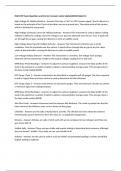NACE CIP Exam Questions and Correct Answers Latest Update(2024) Rated A+
High-Voltage AC Holiday Detector - Answers This uses a 110 V or 220 V power supply. The AC detector is
based on the principle of the Tesla coil and does not use a ground wire. The probe emits a blue corona,
which is attracted to any ground.
High-Voltage Constant Current DC Holiday Detector - Answers This instrument is used to detect coating
holidays in dielectric coatings. Once the voltage is set, pass the electrode over the sur- face. A spark will
arc through the air gap, causing the detector to emit an audible sound.
High-Voltage Pulse-Type DC Holiday Detector - Answers This instrument is ideal for use in moist
conditions. Pass the electrode over the surface. A spark will arc through the air gap at any hol- idays,
voids, or discontinuities, causing the detector to emit an audible sound.
Low-Voltage Holiday Detector - Answers This instrument is a sensitive, low-voltage (wet-sponge)
electronic device powered by a battery with output voltages ranging from 5-120 V DC.
BMR (Base Metal Readings) - Answers To adjust for surface roughness, measure the blast profile of the
steel to be painted at a number of spots to obtain a representative average value. This average value is
the base metal reading (BMR).
DFT Gauge (Type 1) - Answers instruments are described as magnetic pull-off gauges. The force required
to pull a magnet from a ferrous surface is used to determine the film thickness.
DFT Gauge (Type 2) - Answers instruments are electronic gauges. They use electronic circuitry to convert
a reference signal into coating thickness.
BMR (Base Metal Readings) - Answers To adjust for surface roughness, measure the blast profile of the
steel to be painted at a number of spots to obtain a representative average value. This average value is
the base metal reading (BMR).
Wet Film Comb - Answers Instrument used to measure film thickness. The comb is pushed into the film.
Upon removal, the thickness mea- sure is shown on the gauge.
Chlorides - Answers are the salts of hydrochloric acid HCl. The chloride ion forms when the element
chlorine picks up one electron to form the anion Cl− (a negatively-charged ion).
Nitrates - Answers Nitrates are salts of nitric acid with an ion composed of one nitrogen and three oxy-
gen atoms (NO−3).
Soluble Salts - Answers These are non-visible and require testing to determine their presence. Although
they are termed "soluble" they really are not very soluble at all.
Sulfates - Answers are the salts of sulfuric acid; the IUPAC-recommended spelling is sulfate; the British
English spelling is sulphate.
, Acidic Cleaners - Answers Cleaners that remove soil by chemical attack; they dissolve the reaction
products. They are usually composed of fairly strong acids, such as phosphoric acid (H3PO4), with small
quantities of surfactants, water-miscible solvents, and organic wetting and emulsi- fying agents.
Alkaline Cleaners - Answers Cleaners that saponify most oils and greases, and their surface-active
components wash away other contaminants. These cleaners may also saponify certain coating vehicles.
Ceramic Grit - Answers Relatively expensive abrasives that are justified by their special properties. Their
particles retain sharp cutting edges, and are especially effective on hard-base materials which may resist
effective blasting by chilled cast iron grit.
Crushed Slag - Answers Relatively cheap abrasives that are formed from metallurgical processes or
combustion. Copper-, nickel-, coal-, and aluminum-slag are common.
Detergents - Answers Cleaners that are composed of buffering salts, dispersants, soaps, and inhibitors.
They function by wetting, emulsifying, dispersing, and solubilizing the contaminants, which can be
washed away using water (usually hot) or steam.
Dry Grit Blasting (Air Blasting) - Answers Blasting that uses a highly concentrated stream of grit pro-
jected at a surface to remove rust, mill scale, or other contaminants, creating a rough surface that is
good for adhesion.
Emulsion Cleaners - Answers Cleaners that are sprayed onto the surface where they function by wet-
ting, emulsifying, dispersing, and solubilizing the contaminants.
Faying Surfaces - Answers Surfaces joined to create a friction grip.
Gouges - Answers Sharp indentations in the coating.
Inclusions - Answers A non-metallic phase, such as an oxide, sulfide, or silicate particle in a metal.
Organic Solvents - Answers Solvents such as kerosene, turpentine, naphtha, mineral spirits, toluol, xylol,
etc., that clean the metal by dissolving and diluting the oil and grease contamination on the surface.
Pre-Cleaning - Answers Check of the surfaces for contamination before surface preparation begins. Pre-
cleaning involves removing all visible oil, grease, soil, drawing and cutting compounds, and other soluble
contaminants from the surfaces
Surface Lamination - Answers The most common surface defect on steel substrates. It is typically caused
by rolling the steel.
Surface Profile (Anchor Pattern) - Answers The irregular peak and valley profile on a bare surface that
can result from operations such as abrasive blast cleaning or power tool cleaning.
Venturi Nozzle - Answers This blasting nozzle permits abrasive velocity up to 720 kph (450 mph), or 660
ft/s with an almost equal impact over the entire surface. Venturi nozzles are the most effective shape for
tough cleaning jobs.




